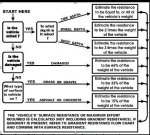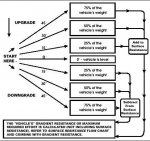I have somewhere got a print out maybe from a US Army manual along the lines of what is below, but as usual I can't find it when needed! So;
From
http://www.pirate4x4.com/tech/billavista/Recovery/index.html
"
Once you have accurately estimated or measured the trucks loaded weight (LW) you can calculate the resistance to be overcome in any recovery situation (this is commonly known as the ROLLING resistance). There are 4 types of resistance that must be accounted for to accurately assess the resistance that must be overcome. These are surface resistance, damage resistance, mire (stuck) resistance and grade (slope) resistance. Calculate them all as follows:
Surface resistance
A pull of 1/10 LW will cause a free wheeling truck to move on a hard, level surface.
A pull of 1/3 LW will cause a free wheeling truck to move on a softer surface, such as grass or gravel,
Damage resistance:
A pull of 2/3 LW will be required to move if the wheels cannot rotate (as if the brakes were fully applied), the pull required to overcome the resistance (drag) the truck id 2/3 or 67% of the LW. Damage resistance includes surface resistance (i.e. you only use one or the other)
Stuck (mire) resistance:
A pull of 100% of LW will be required if the truck is stuck to a depth of the sidewall on the tires.
A pull of 200% of LW will be required if the truck is stuck to the hubs.
A pull of 300% of LW will be required if the truck is stuck to the frame..
Mire resistance includes damage resistance (i.e. you only use one or the other)
Grade (slope) resistance:
Upgrade (vehicle has to be recovered up a slope or grade)
15 degrees - add 25% of LW
30 degrees - add 50% of LW
45 degrees - add 75% of LW
Vehicle recovery on level ground - no correction
Downgrade (vehicle has to be recovered down a slope or grade)
15 degrees - subtract 25% of LW
30 degrees - subtract 50% of LW
45 degrees - subtract 75% of LW
Final figure:
Add surface or damage or mire resistance and grade resistance, and this is your final figure or rolling resistance. This is the amount of pull the winch must apply in order to recover the stuck vehicle.
Example:
My trail rig fully kitted out weighs in at 5000 lbs. I get stuck down a rock ravine that's about 45 degrees steep, and there are big rocks up to the frame hanging it up. Rolling resistance is 5000lbs x 3 + (5000 x 0.75) = 18,750 lbs. As you can see, this is significantly more than the 5000lbs x 1.5 - 7500lbs the manufacturers would have you believe. You may be wondering how one could ever possibly recover the vehicle in this example, given that the largest commercially available 4x4 recovery winch is 15000 lbs and that most are in the 8-9000lb range. The answer is by using multi-line rigging, which we shall explore in a moment. "


